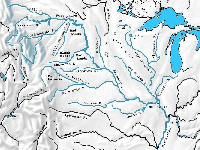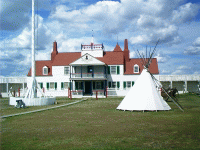
["Fort Union Historic Site." Lewis
and Clark in North Dakota. Online. State Historical
Society of North Dakota. Internet. 12 May 2004. Available http://www.state.nd.us/hist/
lewisclark/attractions_ftUnion.html. Slide 1.]
lewisclark/attractions_ftUnion.html. Slide 1.]
In the beginning, there were no rails, and roads were unimproved. Only herds of migratory ungulates grazed the uplands. I must not say there was no commerce. On the contrary, time out of mind, commerce has followed established trade routes. However, in those days, there were no highways -- unless you consider the western rivers.

In 1836, the American Fur Company acquired the outpost later called Fort Laramie on the Platte River, which traded buffalo hides with the Cheyenne and the Arapaho.
Both posts were supplied from St. Louis. Although hides could be put into bull boats and floated down the Platte in the spring, that river was not really navigable. Goods had to be packed overland to Fort Laramie. The Missouri was a different story. Within three years of its opening, the American Fur Company was operating a steamboat to Fort Union.
Several other fur companies sponsored seasonal rendezvous and built lesser trading posts. At the time, none of these locations were within the United States.
(This slide is my embroidery on an outdoor marker I saw at the Fort Union site.)

["The Missouri and Yellowstone Rivers in North Dakota (Williston Reach): A Report to the Director." General Info N. vol. (n. d.): 55 pars. Online. Internet. 25 Aug. 2004. Available http://gf.nd.gov/info/
mo-riv-whitepaper-williston.html.]
(This photo from the bank of the Missouri River shows the mouth of the Yellowstone to the south. In terms of annual water volume, the Yellowstone contributes slightly more to the Missouri River below this point than the Missouri itself above it does.)

Blockhouse, Fort Union, ND
Each of the succession of directors of the American Fur Company's Upper Missouri Outfit at Fort Union went by the French title "Bourgeois," which I understand better by it's German cognate "Bürger," which means burgher, businessman or merchant or perhaps "Bürgermeister," mayor, burgomaster or bailiff.Stone blockhouses were a feature of the fort from its early days. The Bourgeois never tired of commanding enhancements and repairs to the structure of the fort. Manpower was seldom in short supply, particularly in the off season, and improvements continued up to the beginning of the Civil War.

Assiniboine Parfleche, Fort Union, ND
The trading house entrance was from the alley between the inner and outer main gates. Here, VIPs were entertained during trade negotiations. The Indians, they say, preferred to sit on the floor. Probably, they were not the only ones.The store room at the site is stuffed with goods identical to those displayed in the 1830s, 40s, and 50s. Of course, all the artifacts are modern reproductions, but, interestingly, many of the new articles are produced by successor companies of the original manufacturers by copying museum specimens and rediscovering specifications, molds, methods, and materials of the period.

Bourgeois House, Fort Union, ND
In 1860, Lieutenant Maynadier was surprised at the good order of life at the fort, especially on the evening of August 4 when he attended a ball; "Although the ladies were the daughters of the forest, they were attired in the fashionable style of the States, with hoops and crinoline."[United States. Department of the Interior. National Park Service. Office of Archeology and Historic Preservation. Division of History. Fort Union Trading Post: Historic Structures Report. 1968. By Erwin N. Thompson. Online. National Park Service. Internet. 4 Mar. 2003. Available http://www.nps.gov/fous/hsr/index.htm.]
In the tradition of the French and the British, American commerce had always been conducted in a party atmosphere (and, today, it's the same). Although liquor could be distilled and stored, it was illegal to transport it in the territories and to traffic in it with the Indians. Regulations had negligible effect, though. Whether or not deliberations were sober, all parties were determined that trade be conducted in the time-honored way -- attended with festivals, pageants, joyous occasions, and general merrymaking -- as was amply illustrated in sketches, paintings, and written accounts made on location thoughout the years.

Officers' Quarters (1871), Fort Buford, ND
In the nature of things, fashion changed. Progressively less occidental beaver and more oriental silk were needed by European clothiers. The trade in robes was depressed by smallpox epidemics that may have reduced the small human population on the plains as much as 80% by wiping out whole communities. Ultimately, the buffalo herds were harvested into extinction. The great souls of the fur trade who transcended ethnicity, the pioneers of all the races, the men of renown, grew old and graduated to other pursuits. From the southeast, the Sioux, opposing destiny, tried to stop American settlement by obstructing the trade of other nations. In the United States, the Civil War decimated the economy with the consequence that enforcement of order was feeble on the plains.In 1867, Fort Union was abandoned as unprofitable. The army was tooling up for the Indian Wars and building what would become the massive cantonment of Fort Buford two miles away nearer the mouth of the Yellowstone. The structures at Fort Union were plundered for lumber to build Fort Buford and for firewood for fuel burned in steamboats.